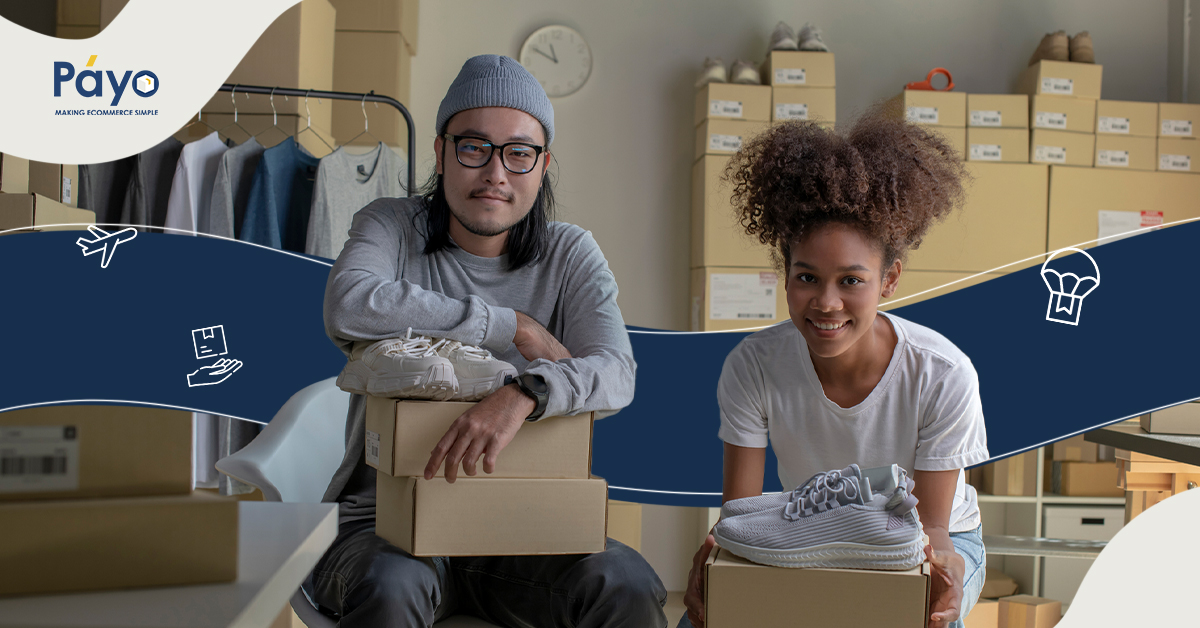The ultimate secret to starting a profitable E-commerce business is finding the right product to sell.
Before you even think about building your website or setting up your online store, you need to identify the needs and wants of the market. This is the only way you can provide them with a product that they simply can’t resist.
In the Philippines, there are numerous products that have proven to be successful in the E-commerce space. But with literally thousands (even millions!) of products out there, making the right choice can be extremely overwhelming.
If you want to be inspired and get some ideas, here are some of the products you can consider selling!
20 Profitable Products to Sell Online in the Philippines
As a budding entrepreneur, you need to ensure that the products you sell online are not only profitable but also in demand. We’ve listed some of them here.
1. Coffee and coffee equipment
Price range: P500 to P5,000
Profit margin: 10% to 30%
From baristas to students, everyone craves a good cup of joe. With the rise of specialty coffee shops in the country, there’s never been a better time to sell coffee beans, brewing equipment, and other coffee-related accessories. Whether it’s a hand-held frother, a pour-over kit, or a fancy espresso machine, you’ll surely get tons of sales if you market your products right.
2. Baked goods
Price range: P50 to P2,500
Profit margin: 10%
Baked goods have always been a hit in the Philippines, not only for special occasions, but even for normal days.
From classic ensaymadas to trendy cupcakes and desserts, there’s a wide range of sweet treats to choose from. You can even try your luck in selling artisanal bread. You can also offer customized cakes and pastries that cater to specific dietary needs, such as gluten-free or vegan options. If you want to go the extra mile, package your goods in attractive boxes or baskets to make them perfect gifts for any occasion.
3. Pet accessories
Price range: P300 to P2,000
Profit margin: 20%
Pet accessories are a hot commodity in the Philippines. From leashes and collars to pet beds and toys, there’s a huge market for quality and stylish pet accessories.
Tap into this market by offering a variety of products that cater to different pet sizes and needs. You can also offer personalized items, such as customized collars or beds with your customer’s pet’s name embroidered on them. With the right marketing strategy, you can reach a wide audience of pet owners and grow your business quickly.
4. Clothes
Price range: P250 to P5,000
Profit margin: 40% to 50%
From casual wear to formal attire, there are endless opportunities in the clothing industry. The key is to identify a specific niche and cater to it. This can be anything from trendy streetwear to vintage-inspired outfits.
By offering a unique selection of clothing items, you can attract a loyal following of customers who are looking for something different. You can also consider offering clothing items for specific occasions, such as themed parties, weddings, or corporate events.
5. Phone cases
Price range: P50 to P1,500
Profit margin: up to 70%
Phone cases are a must-have accessory for today’s smartphone users. They can protect your phone from scratches and dents while adding a personal touch to your mobile device. The only challenge to selling phone cases is you have to stock various cases for different models.
6. Kitchenware items
Price range: P100 to P10,000
Profit margin: up to 80%
As a home cook or chef, having the right kitchenware can make all the difference in the world. From high-quality knives and pans to specialized appliances, there’s a huge market for kitchenware items in the country.
You can offer a range of products that cater to different cooking styles and budgets. For instance, if you want to set up a high-end store, you can sell cast iron pans or Le Creuset pots.
7. Homeware items
Price range: P100 to P10,000
Profit margin: up to 80%
Homeware items are a staple in any household. After all, we all want our homes to look the best.
You may specialize in a niche of products or offer a wide range of items that cater to various styles and budgets.
8. Accessories
Price range: P50 to P5,000
Profit margin: 20% to 100%
Accessories are a great way to add a personal touch to any outfit or style. From jewelry, watches, bags, or belts, there’s so many things you can sell. It’s up to you if you want to offer budget-friendly items or luxury ones.
9. Candles
Price range: P500 to P1,500
Profit margin: 25% to 50%
Candles have always been a popular product in the Philippines, as they add warmth and ambiance to any room. With the rise of aromatherapy and wellness trends, there’s a huge market for scented candles that offer relaxation and stress relief.
You can offer a range of scents that cater to different moods and preferences, such as lavender for relaxation or citrus for an energizing boost.
10. Skincare items
Price range: up to P2,500
Profit margin: 30%
Skincare items are a necessity in everyone’s daily routine, and with more people becoming conscious about their skin health, there’s never been a better time to invest in this industry. From cleansers and moisturizers to serums and masks, there’s a wide range of skincare items to choose from.
11. Makeup
Price range: P90 to P4,000
Profit margin: up to 50%
Makeup is another popular industry in the Philippines, with a huge market for beauty products that cater to different skin types and preferences.
From basic makeup essentials like foundation and lipstick to advanced tools like contouring palettes and false lashes, there’s no shortage of products to offer. You can also consider specializing in a particular type of makeup, such as organic or vegan products, to attract a specific demographic.
12. Baby Clothing
Price range: up to P2,500
Profit margin: 30% to 40%
Soft, comfortable, and cute baby clothing is always in demand since parents are always eager to dress their little ones up in adorable outfits that are not only stylish but also functional.
13. Zero waste products
Price range: P50 to P1,500
Profit margin: up to 50%
Zero-waste products are becoming increasingly popular in the Philippines as people become more environmentally conscious. This includes items such as reusable cloth bags, bamboo utensils and straws, and refillable containers.
14. Athleisure
Price range: P500 to P4,000
Profit margin: up to 50%
Athleisure wear is a booming industry that combines comfort and style. From leggings and sports bras to tracksuits and sneakers, there are so many products you can sell. This clothing trend is also expected to boom even further in the next few years.
15. Furniture
Price range: up to P25,000
Profit margin: 20% to 50%
From cozy armchairs, elegant coffee tables, or functional desks and bookcases, you can sell stylish furniture that transforms any space into a comfortable haven. The key to success in this industry is to offer unique and high-quality pieces that will last for a long time.
16. Perfumes
Price range: P150 to P6,000
Profit margin: up to 50%
Perfumes are luxurious products that have been in demand for centuries. With so many different scents and fragrances available, the perfume industry is a lucrative market to invest in. You can sell designer perfumes, niche fragrances, or make your own unique scents.
17. Thrifted goods
Price range: P50 to P1,500
Profit margin: up to 300%
Thrifted goods are a sustainable and affordable option for those who love unique and vintage items. You can curate a collection of second-hand clothing, accessories, and home decor pieces that are in good condition and offer them at a competitive price.
18. Bikinis
Price range: P250 to P3,600
Profit margin: 20% to 50%
Bikinis are a must-have item for beach vacations in the Philippines, especially in the summer. You can sell anything from classic two-piece swimsuits to trendy one-piece styles. Aside from the suits themselves, you can also sell cover ups and other beach accessories.
19. Organizers
Price range: P50 to P500
Profit margin: 40%
Organizers are an essential item for anyone who wants to keep their space clean and clutter-free. You can sell a wide range of organizers such as closet organizers, desk trays, or makeup storage. You can also consider offering custom-made organizers to fit specific spaces and needs.
20. Healthy snacks
Price range: P50 to P500
Profit margin: up to 60%
Healthy snacks are becoming increasingly popular in the Philippines as more people prioritize their health and well-being. From protein bars, energy balls, dried fruits, and nuts, there’s a wide range of nutritious and delicious snacks that you can sell.
Tips for Choosing the Best Products to Sell Online
As an online seller, choosing the right products to sell can make or break your business. Here are some tips to help you choose the best products to sell online.
Consider the ease of shipping
Bulky or fragile items may require special packaging and handling, which can increase shipping costs and lead to unhappy customers if the items arrive damaged.
As much as possible, choose products that are easy to package and ship such as small and lightweight items. If you choose items that are harder to ship, make sure to factor in the extra cost and effort to ship these items.
Take a look at emerging trends
Staying up to date with emerging trends in your industry can give you the competitive advantage that you need. Keep an eye on social media, magazines, and other resources to see what products are gaining popularity.
You can even use tools like Google Trends and social media analytics to track what people are searching for and talking about in your industry.
Find products that are guilty pleasures
Guilty pleasure products cover items that people enjoy indulging in, even if they may not necessarily need them.
These can often be impulse buys that customers are more likely to purchase on a whim. Guilty pleasures can also be related to hobbies like sports and photography.
Assess the ease of keeping your inventory stocked
When choosing products to sell online, it’s important to consider the ease of keeping your inventory stocked. Look for products that have a consistent supply chain and are easy to restock when you run out of inventory.
It’s also important to consider the shelf life of your products, especially if you are selling perishable items like food.
Consider the profit margin
It’s important to strike a balance between affordability for your customers and profitability for your business.
You want to choose products that you can source at a reasonable price and sell at a markup that allows you to make a decent profit. This way, you can keep your business sustainable and continue to grow over time.
Choosing Products to Sell Online FAQs
Still have questions about picking products to sell online? We’ll answer them below.
How do I choose the right product to sell online?
When choosing the right product to sell online, consider the ease of shipping, emerging trends in your industry, guilty pleasure products, the ease of keeping your inventory stocked, and its profit margin. When you find a product that meets these criteria, your business will have a higher chance of success.
Another important factor is that you like what you’re selling and that you stand by your products, so don’t overlook this!
How do I research the market for the products I want to sell?
To research the market for the products you want to sell, start by looking at your competition and analyzing their pricing, marketing strategies, and customer reviews.
You can also use online tools like Google Trends, social media analytics, and market research reports to get a better understanding of customer demand, market saturation, and emerging trends.
Additionally, you can survey potential customers to get their feedback on your product ideas and assess their willingness to pay for them.
Should I sell a niche product or a broad product category?
Deciding whether to sell a niche product or a broad product category ultimately depends on your business goals and target audience.
Niche products offer the advantage of catering to a specific audience, which can help you establish a loyal customer base and stand out from your competitors. However, the market for niche products may be smaller, which can limit your growth potential.
On the other hand, selling a broad product category can appeal to a wider audience, but may also increase competition and make it harder to differentiate yourself from other sellers.
Always consider your resources, market demand, and the competition before deciding on what type of products to sell online.
How do I know if there is enough demand for the product I want to sell?
To determine if there is enough demand for the product you want to sell, you can conduct market research by looking at factors such as search volume, social media mentions, and customer reviews online.
You can also survey potential customers to gauge their interest in your product and assess their willingness to pay for it.
Additionally, you can analyze your competition to see how they are performing in the market and if there is room for another player in the space.
By doing your due diligence and gathering data, you can make an informed decision on whether or not to move forward with selling a particular product.
What are some ways to differentiate my product from competitors?
There are several ways you can differentiate your product from competitors. One way is to focus on quality and offer a superior product that is made with higher-quality materials or ingredients.
Another way is to offer unique features or benefits that competitors don’t have, such as a longer warranty, customization options, or a rewards program.
You can also differentiate your product through branding and marketing, by creating a compelling brand story and using social media and other platforms to connect with your audience and build a loyal following.
Lastly, consider adding value to your product through exceptional customer service, such as offering free shipping or a satisfaction guarantee. This can help build trust and loyalty with your customers.
How do I find a reliable supplier for my chosen product?
Finding a reliable supplier for your chosen product can be a daunting task, but there are several ways to go about it.
One way is to attend trade shows and networking events in your industry to meet potential suppliers in person and get a sense of their products and services.
You can also research suppliers online through industry directories, online marketplaces, and forums.
Do not forget to vet potential suppliers thoroughly by checking their credentials, reviews, and references, as well as their manufacturing and quality control processes.
How can I test the viability of a product before committing to selling it online?
Before committing to selling a product online, it’s important to test its viability to minimize risks and maximize profits.
You can do this by conducting a small-scale test that involves selling the product on a marketplace. By testing the viability of your product, you can minimize risk and make informed decisions about your business’s future.
How do I price my product competitively without sacrificing profit margins?
When pricing your product, it’s important to strike a balance between competitiveness and profitability.
Research your competitors’ prices and adjust your prices accordingly. Consider your production costs, shipping costs, and overhead expenses when setting your prices.
You may try experimenting with different pricing strategies as well. Ultimately, it’s important to keep a close eye on your profit margins and adjust your prices as necessary to ensure the long-term success of your business.
What are the legal and regulatory requirements I need to consider when selling products online?
When selling products online, there are several legal and regulatory requirements you need to consider. These may include obtaining the necessary permits and licenses from your barangay or mayor’s office as well as the BIR and DTI.
You are also expected to provide accurate product descriptions and honor warranty claims.
How do I manage inventory and order fulfillment for my online store?
Managing inventory and order fulfillment for your online store is crucial to the success of your business.
It is recommended to use an inventory management software that tracks the quantity of each product and alerts you when it’s time to reorder. You can also use dropshipping, where you partner with a manufacturer or wholesaler who fulfills the orders for you.
When it comes to order fulfillment, you can either handle it in-house or use a third-party logistics provider that can store, pick, pack, and ship your products for you. By choosing the latter option you can focus more on marketing your products.
Want a partner to help you with everything E-commerce? Sign up with Payo today or send us a message at [email protected].







